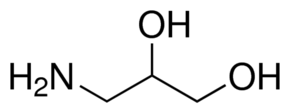Iso Serinol (CAS Number : 616-30-8)
3-Amino-1,2-propanediol (CAS No. 616-30-8) is used in the preparation of iohexol, which is a X-CT non-ionic contrast medium. It acts as a starting material in the production of specialty materials.

Chemical and Physical Properties :
| Property Name | Property Value |
|---|---|
| Molecular Weight | 91.11 g/mol |
| Hydrogen Bond Donor Count | 3 |
| Hydrogen Bond Acceptor Count | 3 |
| Rotatable Bond Count | 2 |
| Complexity | 32 |
| Monoisotopic Mass | 91.063 g/mol |
| Exact Mass | 91.063 g/mol |
| XLogP3-AA | -2 |
| CAS Number | 616-30-8 |
| Compound Is Canonicalized | true |
| Formal Charge | 0 |
| Heavy Atom Count | 6 |
| Defined Atom Stereocenter Count | 0 |
| Undefined Atom Stereocenter Count | 1 |
| Defined Bond Stereocenter Count | 0 |
| Undefined Bond Stereocenter Count | 0 |
| Isotope Atom Count | 0 |
| Covalently-Bonded Unit Count | 1 |
Other names of Iso serinol (CAS No. 616-30-8) :
- 3-Amino-1,2-propanediol
- 616-30-8
- 3-Aminopropane-1,2-diol
- 1-Amino-2,3-propanediol
- 2,3-Dihydroxypropylamine
- 1,2-Propanediol, 3-amino-
- 1-Aminoglycerol
- 2,3-Propandiol-1-amine
- 1-Aminopropanediol
- 3-aminopropan-1,2-diol
- 3-Amino-1,2-proopanediol
- (+/-)-3-Amino-1,2-propanediol
- 1-Amino-2,3-dihydroxypropane
- 3-Amino-1,2-propanediol, 98%
- aminopropan-2,3-diol
- amino-2,3-propanediol
- 3-amino-l,2-propandiol
- 3-amino1,2-propanediol
- 1-amino-2,3-propandiol
APPLICATIONS
Amino alcohols which have the physical and chemical characteristics of both alcohols and amines in one molecule . The amino alcohols are highly useful materials for a wide variety of applications.
Chemcial intermediate application
The amino alcohols are useful intermediates for a wide variety of synthesis. Many chemical reactions are common to the amino alcohols to form following examples;
- amides and amide esters with carboxylic acids and organic acid esters
- amino acids by oxidation of the alcohol and by hydrolysis of the amide
- diamines with nitro alcohols
- heterocyclic organic compounds such as oxazoline by dehydration
- oxazolidine with aldehydes or ketones
- oxazoline esters and diesters with three moles of an organic acid
- salts with inorganic acids
Emulsifier applications
Amino alcohols are used for production of efficient anionic emulsifiers and nonionic polyethylene emulsions. They appear in personal care products formulations and show better base strength, lower neutral equivalent, and lower volatility than traditional amine emulsifiers. Amino alcohols are used in personal-care products with the neutralization function of acid raw materials. They render resinous materials water-soluble. They provide base strength values with low odor levels, good water and alcohol solubility and color stability in cosmetics.
Coating application
The difunctionality of amino alcohols makes them useful as raw materials in polymer applications in both water- and solvent-based to increase the solubility of other components and improve solution stability. They function as a pigment dispersion-aid dispersant to enhance the wetting and viscosity stability. The salts of the amino alcohols are also used in coating to improve the package stability.
Corrosion Inhibition application
Amino Alcohols maintain a constant alkalinity in the boiling water flows and condensate not to form solid products which would impede line flow. This function is applied for corrosion Inhibits. They are widely employed in the preparation of water soluble cationic flocculants and ion exchange resins which adsorb solid and colloidal particles by electrostatic attraction. They are used for water treatment, metal treatment and absorption of CO2 gas.
Catalyst application
The salts of the amino alcohols like not only hydrochloride salts but also nitrate, sulfate, phosphate, and sulfonate salts can be used alone or in combination with other catalysts for balanced curing action with selected textile-resins.
Biochemical application
In biological field, amino alcohol structure is widely found in many drugs especially antihistamines. Sphingosine, the major base of the sphingolipids in mammals for signal transmission and cell recognition is an amino alcohol. Amino alcohol compounds are the starting materials in the preparation of beta-lactam antibiotics, humectant for foods and cosmetics, flavouring agents as well as many oral, injectable or topical pharmaceuticals. Amino alcohols are amine buffers used in a variety of medications.






